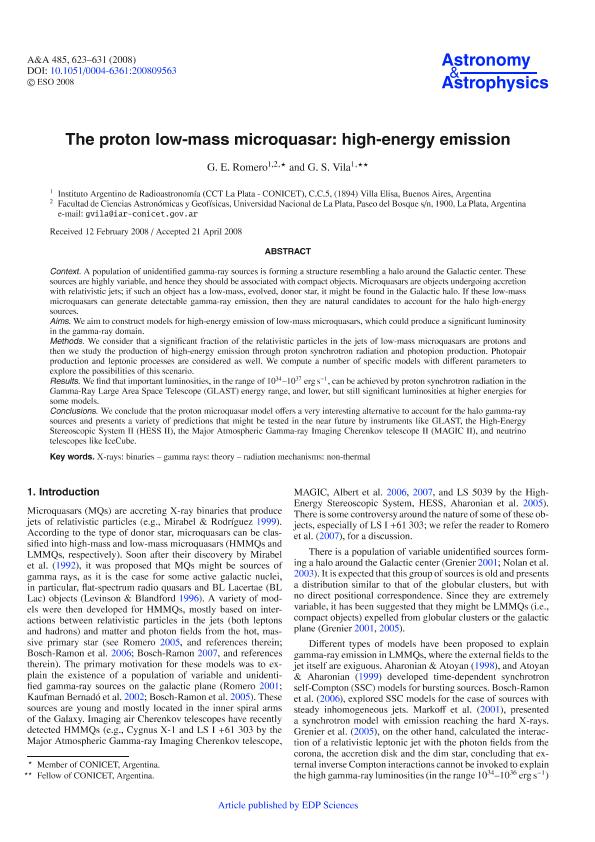Mostrar el registro sencillo del ítem
dc.contributor.author
Romero, Gustavo Esteban

dc.contributor.author
Vila, Gabriela Soledad

dc.date.available
2017-10-23T21:04:47Z
dc.date.issued
2008-12
dc.identifier.citation
Romero, Gustavo Esteban; Vila, Gabriela Soledad; The proton low-mass microquasar: high-energy emission; EDP Sciences; Astronomy and Astrophysics; 485; 3; 12-2008; 623-631
dc.identifier.issn
0004-6361
dc.identifier.uri
http://hdl.handle.net/11336/26963
dc.description.abstract
Context: A population of unidentified gamma-ray sources is forming a structure resembling a halo around the Galactic center. These sources are highly variable, and hence they should be associated with compact objects. Microquasars are objects undergoing accretion with relativistic jets; if such an object has a low-mass, evolved, donor star, it might be found in the Galactic halo. If these low-mass microquasars can generate detectable gamma-ray emission, then they are natural candidates to account for the halo high-energy sources. Aims: We aim to construct models for high-energy emission of low-mass microquasars, which could produce a significant luminosity in the gamma-ray domain. Methods: We consider that a significant fraction of the relativistic particles in the jets of low-mass microquasars are protons and then we study the production of high-energy emission through proton synchrotron radiation and photopion production. Photopair production and leptonic processes are considered as well. We compute a number of specific models with different parameters to explore the possibilities of this scenario. Results: We find that important luminosities, in the range of 1034–1037 erg s−1, can be achieved by proton synchrotron radiation in the Gamma-Ray Large Area Space Telescope (GLAST) energy range, and lower, but still significant luminosities at higher energies for some models. Conclusions: We conclude that the proton microquasar model offers a very interesting alternative to account for the halo gamma-ray sources and presents a variety of predictions that might be tested in the near future by instruments like GLAST, the High-Energy Stereoscopic System II (HESS II), the Major Atmospheric Gamma-ray Imaging Cherenkov telescope II (MAGIC II), and neutrino telescopes like IceCube.
dc.format
application/pdf
dc.language.iso
eng
dc.publisher
EDP Sciences

dc.rights
info:eu-repo/semantics/openAccess
dc.rights.uri
https://creativecommons.org/licenses/by-nc-sa/2.5/ar/
dc.subject
X Ray Binaries
dc.subject
Gamma Rays
dc.subject
Radiation Mechanisms
dc.subject
Non Thermal Mechanisms
dc.subject.classification
Otras Ciencias Físicas

dc.subject.classification
Ciencias Físicas

dc.subject.classification
CIENCIAS NATURALES Y EXACTAS

dc.title
The proton low-mass microquasar: high-energy emission
dc.type
info:eu-repo/semantics/article
dc.type
info:ar-repo/semantics/artículo
dc.type
info:eu-repo/semantics/publishedVersion
dc.date.updated
2017-10-12T19:38:52Z
dc.journal.volume
485
dc.journal.number
3
dc.journal.pagination
623-631
dc.journal.pais
Francia

dc.description.fil
Fil: Romero, Gustavo Esteban. Provincia de Buenos Aires. Gobernación. Comisión de Investigaciones Científicas. Instituto Argentino de Radioastronomía. Consejo Nacional de Investigaciones Científicas y Técnicas. Centro Científico Tecnológico Conicet - La Plata. Instituto Argentino de Radioastronomía; Argentina
dc.description.fil
Fil: Vila, Gabriela Soledad. Provincia de Buenos Aires. Gobernación. Comisión de Investigaciones Científicas. Instituto Argentino de Radioastronomía. Consejo Nacional de Investigaciones Científicas y Técnicas. Centro Científico Tecnológico Conicet - La Plata. Instituto Argentino de Radioastronomía; Argentina
dc.journal.title
Astronomy and Astrophysics

dc.relation.alternativeid
info:eu-repo/semantics/altIdentifier/doi/http://dx.doi.org/10.1051/0004-6361:200809563
dc.relation.alternativeid
info:eu-repo/semantics/altIdentifier/url/https://www.aanda.org/articles/aa/abs/2008/27/aa09563-08/aa09563-08.html
Archivos asociados
